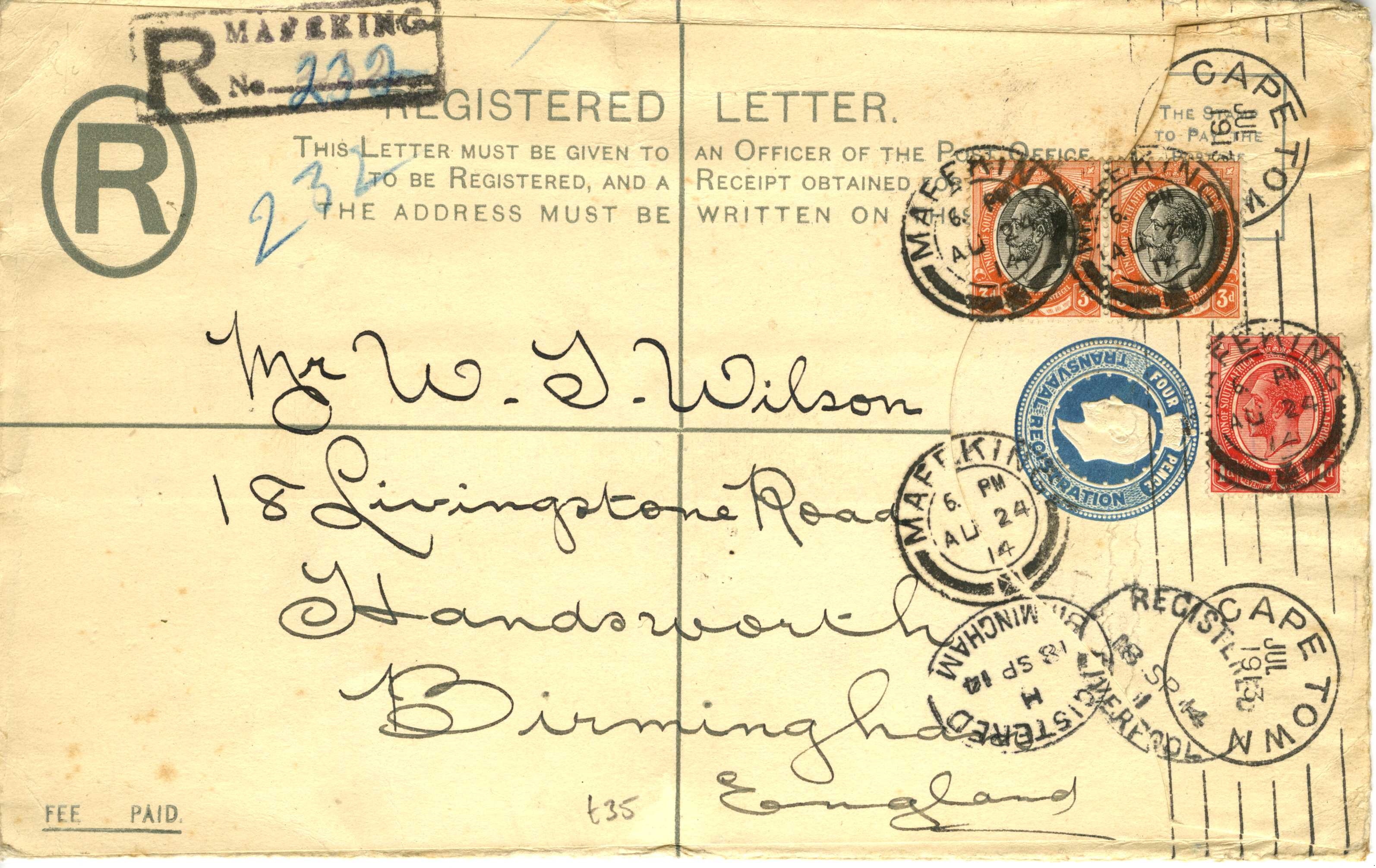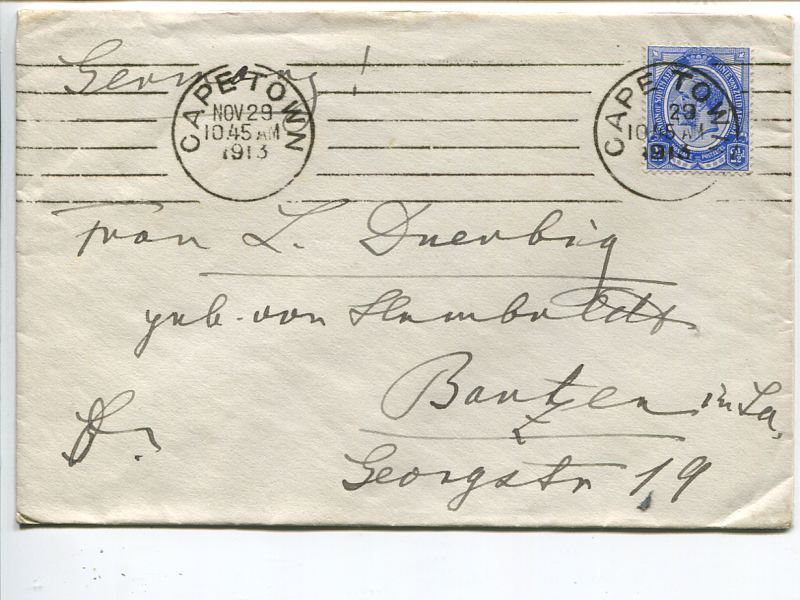Use of machine cancellation on a registered cover
Quote from Bas PAYNE on June 28, 2022, 2:32 pmThe attached cover looks, at first sight, fairly routine: a lager size Transvaal registered cover sent in 1914 from Mafeking (Cape Province) to Birmingham, with appropriate stamps, cancellations, transit and arrival date-stamps (the reverse has no markings). After Union, Transvaal stamps and postal stationery were valid for use in the Cape and the rest of the new Union of South Africa, and are regularly found used in the Cape.
What's odd is the machine postmark, applied across the flap. It was clearly applied before the cover was used in 1914, as it underlies the stamps; however it is dated about a year earlier (JUL 1913), and machine cancellations aren't normally found on registered envelopes, which are handled singly for obvious reasons, while machine cancellers are used for large volumes of ordinary mail. Also odd is that while the machine cancellation has the usual 6 straight lines that would be expected in July 1913, the format of the date and time is odd. usually you'd expect the format in the second attached image - e.g. NOV 29 / 10.45 AM / 1913; but in the cancellation on the registered cover all we have is "JUL / 1913 / ".
The dealer from whom I bought it suggested that the purpose might have been to validate the use of the Transvaal registered envelope in the Cape; but I've seen plenty of other Transvaal covers used after May 1910 in the Cape, and haven't seen another with this kind of machine cancellation. Has anyone else seen one?; or does anyone have another explanation?
The attached cover looks, at first sight, fairly routine: a lager size Transvaal registered cover sent in 1914 from Mafeking (Cape Province) to Birmingham, with appropriate stamps, cancellations, transit and arrival date-stamps (the reverse has no markings). After Union, Transvaal stamps and postal stationery were valid for use in the Cape and the rest of the new Union of South Africa, and are regularly found used in the Cape.
What's odd is the machine postmark, applied across the flap. It was clearly applied before the cover was used in 1914, as it underlies the stamps; however it is dated about a year earlier (JUL 1913), and machine cancellations aren't normally found on registered envelopes, which are handled singly for obvious reasons, while machine cancellers are used for large volumes of ordinary mail. Also odd is that while the machine cancellation has the usual 6 straight lines that would be expected in July 1913, the format of the date and time is odd. usually you'd expect the format in the second attached image - e.g. NOV 29 / 10.45 AM / 1913; but in the cancellation on the registered cover all we have is "JUL / 1913 / ".
The dealer from whom I bought it suggested that the purpose might have been to validate the use of the Transvaal registered envelope in the Cape; but I've seen plenty of other Transvaal covers used after May 1910 in the Cape, and haven't seen another with this kind of machine cancellation. Has anyone else seen one?; or does anyone have another explanation?
Uploaded files:
Quote from louwrence on June 28, 2022, 6:52 pmHere is some notes:
- 4d --> Registered Letter rate but cancelled by machine canceller in July 1913
- 7d -> Cancelled on Monday, 14 August 1914 -> This left enough time for the envelope to travel to Cape Town before the mail ship left for England, at 4pm on Thursday, 17 August 1914.
- Registered letter rate = 4d
- Letter rate to countries in the British Empire = 1d per 1/2 oz.
- The 2d is not for late fee which was a minimum of 3d for being 15 minutes late. The 2d is for 1 oz. extra, thus the letter weighed 1,5 oz maximum.
If the Post Office in the Cape Province did cancel all the postal stationary from the other three colonies, one should be able to find more of them used in this way. This would have been against postal regulations of the Union of South Africa that allowed the used of colonial stamps and postal stationary to be used until 31 December 1937.
The folds at the top and bottom of the envelope show that there could have been a thick document sent in the envelope. If the effect of the machine cancellation was disregarded by the post office then the total weight of the letter could have been between 3 and 3,5 oz.
Here is some notes:
- 4d --> Registered Letter rate but cancelled by machine canceller in July 1913
- 7d -> Cancelled on Monday, 14 August 1914 -> This left enough time for the envelope to travel to Cape Town before the mail ship left for England, at 4pm on Thursday, 17 August 1914.
- Registered letter rate = 4d
- Letter rate to countries in the British Empire = 1d per 1/2 oz.
- The 2d is not for late fee which was a minimum of 3d for being 15 minutes late. The 2d is for 1 oz. extra, thus the letter weighed 1,5 oz maximum.
If the Post Office in the Cape Province did cancel all the postal stationary from the other three colonies, one should be able to find more of them used in this way. This would have been against postal regulations of the Union of South Africa that allowed the used of colonial stamps and postal stationary to be used until 31 December 1937.
The folds at the top and bottom of the envelope show that there could have been a thick document sent in the envelope. If the effect of the machine cancellation was disregarded by the post office then the total weight of the letter could have been between 3 and 3,5 oz.


